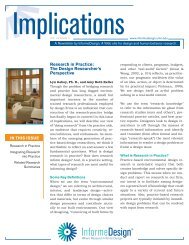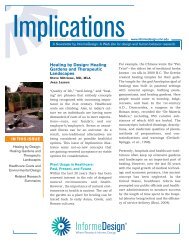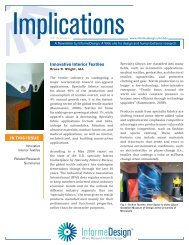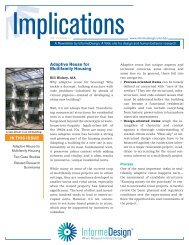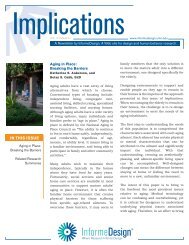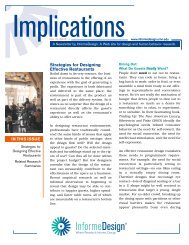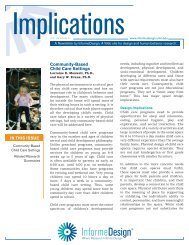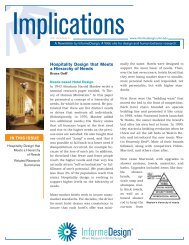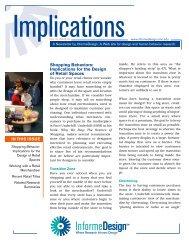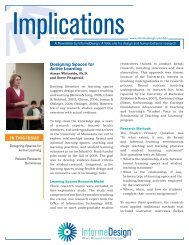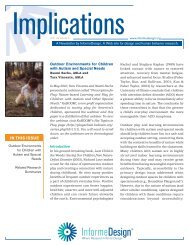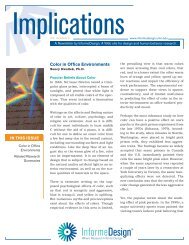Design, Landscape, and Health: Volume 5, Issue 4 - InformeDesign
Design, Landscape, and Health: Volume 5, Issue 4 - InformeDesign
Design, Landscape, and Health: Volume 5, Issue 4 - InformeDesign
Create successful ePaper yourself
Turn your PDF publications into a flip-book with our unique Google optimized e-Paper software.
Implications<br />
www.informedesign.umn.edu<br />
<br />
Gardens, because of their perceived pleasantness,<br />
can encourage exercise <strong>and</strong> movement. They<br />
should thus offer easy wayfinding <strong>and</strong> provide<br />
destinations that encourage mild exercise.<br />
4. Provide for access to nature <strong>and</strong> positive<br />
distractions. Exposure to nature <strong>and</strong> natural<br />
scenes is associated with decreased physiological<br />
stress responses. This response is dose-related in<br />
that the greater the percentage of greenery, as opposed<br />
to hardscape, the more likely the relaxation<br />
response is to occur. This relaxation response is<br />
believed to be ‘hardwired’ into our nervous systems<br />
by evolutionary responses to environments<br />
that favored survival.<br />
5. Minimize ambiguity. Stressed individuals<br />
respond negatively to ambiguity. Studies of inpatients<br />
recovering from surgery showed increased<br />
stress levels when exposed to abstract paintings<br />
as compared with natural scenes. This is believed<br />
to be due to the perception of ambiguous stimuli<br />
as negative in stressed individuals, congruent<br />
with their emotional state.<br />
6. Minimize intrusive stimuli. To exert their effect,<br />
therapeutic gardens need to minimize negative<br />
distractions such as noise, odor, <strong>and</strong> bright lights.<br />
Noise in particular can negate the positive effects<br />
associated with viewing nature.<br />
Case Study: A Therapeutic Garden<br />
for People Living With HIV<br />
Prescribing with the <strong>L<strong>and</strong>scape</strong><br />
Creating a therapeutic l<strong>and</strong>scape involves three<br />
steps:<br />
1. The evaluation of the disease <strong>and</strong>/or patient is<br />
used to generate potential target symptoms or disease<br />
processes to be addressed by the design.<br />
2. After attaining a thorough underst<strong>and</strong>ing of the<br />
disease, disease processes, <strong>and</strong> social <strong>and</strong> psychological<br />
factors, the design is created based upon<br />
the target symptoms that the designer wishes<br />
to ameliorate. In addition, the methodology for<br />
evaluating the influence of the garden on the patient<br />
population is developed. This methodology is<br />
based upon the intent of the design <strong>and</strong> is used to<br />
measure its effectiveness.<br />
3. Once the garden is installed <strong>and</strong> occupied, the<br />
health, psychological, <strong>and</strong> social parameters determined<br />
in the previous step are evaluated. The<br />
data collected are then used to determine the effectiveness<br />
of the design based upon the intended<br />
function of the garden. Undesired effects are also<br />
evaluated.<br />
The design of a therapeutic garden for Clare Housing,<br />
an apartment building for patients with HIV disease,<br />
illustrates the process by which therapeutic garden<br />
spaces may be designed <strong>and</strong> scientifically analyzed<br />
to determine their safety <strong>and</strong> effectiveness for a given<br />
user group.<br />
A water feature can mask undesired noises.<br />
1. Evaluating the Disease <strong>and</strong> the Patient<br />
HIV Disease<br />
Human immunodeficiency virus (HIV) attacks the<br />
immune system. Untreated, HIV disease is progressive<br />
<strong>and</strong> fatal. Death takes place over a period of<br />
months to years. Recent changes in the drug therapy<br />
of HIV disease has, however, created the opportunity<br />
to greatly extend the lives of people infected with<br />
HIV <strong>and</strong>, in some cases, lead to a remission of the<br />
disease. This life extension has paradoxically led to<br />
Where Research Informs <strong>Design</strong>®



